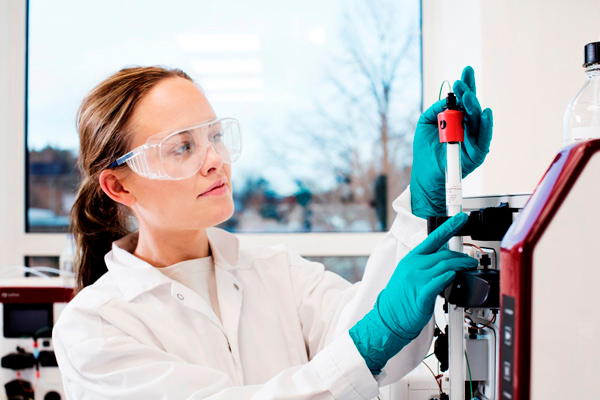-
Superdex 30 Increase
Peptides and other small biomolecules, fractionation range Mr ~ 100 to ~ 7000.
-
Superdex 75 Increase
Recombinant tagged proteins, fractionation range Mr ~ 3000 to ~ 70 000.
-
Superdex 200 Increase
MAb and other antibodies, fractionation range Mr ~ 10 000 to ~ 600 000.
-
Superose 6 Increase
Larger proteins and protein complexes, fractionation range Mr ~ 5000 to ~ 5 000 000.
What our customers are saying
Dr. Tomohiro Nishizawa @ Nureki Laboratory, Department of Biological Sciences, Graduate School of Science, The University of Tokyo
"Now I can work on more samples, resulting in higher throughput. I can now purify a protein in 30 minutes instead of an hour
We asked Dr. Tomohiro Nishizawa, who frequently purifies membrane proteins for crystallization, how he likes the new size exclusion chromotography column Superose 6 Increase. He is pleased with the shorter purification time and higher throughput compared with standard Superose 6 columns.
Purification time was the bottleneck.
Using the Superose 6 column, I was able to perform fractionation on my membrane protein samples. However, low throughput was a major problem. For example, it usually takes one hour to purify one sample. Then there are hours of preparation and clean-up time. So it was difficult to purify multiple samples in a day.
We heard that the new Superdex 200 Increase has an extremely high resolution and an increased flow rate. So we gave the column a try to see if it would shorten the purification time. Membrane proteins tend to form micelles in detergents, resulting in a higher molecular weight. Unfortunately, the larger size pushed the target protein outside of the fractionation range for Superdex 200 Increase. The peak for the target protein came very close to the void volume peak area, so proper fractionation was not possible.
Now purification time is cut in half
Superose 6 Increase, on the other hand, has a fractionation range that is compatible with my membrane protein micelles. Therefore, the fractionation is going very well. I am especially satisfied because I can set a higher flow rate with this new column, resulting in a shorter purification time. I am surprised that I can now purify a protein in 30 minutes instead of an hour. This time savings allows me to purify three or four different samples in a day, which enables quicker mutant screening and faster results."
Method Purification system: ÄKTAexplorer 10S
Purification environment: 4°C
Sample: Membrane protein produced by insect cell expression system
Buffers: 10 mM HEPES, 150 mM NaCl, detergent
Ciaran McKeown @Department of Medicine, Imperial College London
"We use SEC MALS (size exclusion chromatography multiangle light scattering) to determine absolute molecular weight for proteins and protein complexes. It is a very powerful technique and for the SEC part we need a column that will give us good separation and good resolution. We have tried a column that we bought with the system, this gives reasonable results but fractionation range was limiting.
We also tried [the legacy product] Superose 6 3.2/300 but this required such a slow flow rate the signal to noise was too high. We also tried a silica based column for a better fractionation range but were a bit limited with pH range and buffer choice due to it being silica based. Now we use the Superdex 200 Increase 10/300 and the Superose 6 Increase regularly for this technique. The Increase columns give us better pressure limits, increased flow rate, buffer compatibility, and good resolution.The one area we do run into problems is if we have very large complexes, up to 1 MDa [Mr 1 000 000] and our sample comes out in the void volume. In this case the sample can be mixed with aggregates and contaminants in the void and give an impure sample for downstream analysis."
Learn more about Superdex 200 Increase and Superose 6 Increase
Andreas Lehmann @ Molecular Partners AG
"We use the Superdex 200 Increase 5/150 for screening purposes. Since the switch to this newer generation of Superdex we have analyzed more than 10 000 samples. I really like the speed and consistent behavior, which helped us to increase the throughput of this process step."
Learn more about Superdex 200 IncreaseIan A Taylor @ Macromolecular Structure Laboratory, Francis Crick Institute, London
"Even at twice the flow rate, resolution is still better than with the regular Superdex 75 column. Only minimal increases in peak broadening are observed with increasing flow rate (0.5, 0.8, and 1.0 mL/min). In conclusion, the new [Increase] 10/300 column offers significant improvements over the Superdex 75 (10/300) column. It means we can conduct multiangle light scattering (MALS) runs in half the time and with increased chromatographic resolution. The increased backpressure is not a significant problem if using a chromatography system that manages these pressures adequately."
Learn more about Superdex 75 IncreaseDr. Paul Wan @ Discovery Sciences, AstraZeneca R&D, UK
"The resolution was much better than with the standard Superdex 75 column. Increasing the flow rate (0.5, 0.75, 1.5 mL/min) didn’t seem to affect the good resolution on the column. I was amazed at how little loss in resolution I got when increasing the flow rate (0.5, 0.75, 1.5 mL/min). The runs were so much faster than before"
Learn more about Superdex 75 Increase